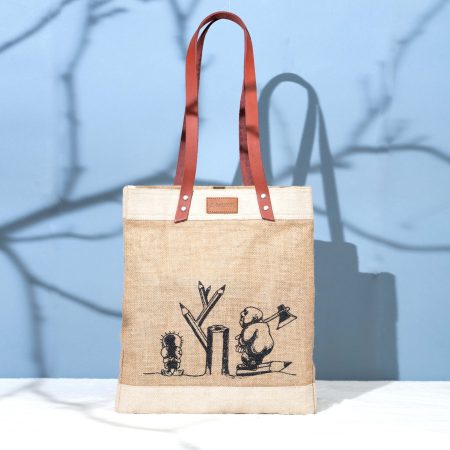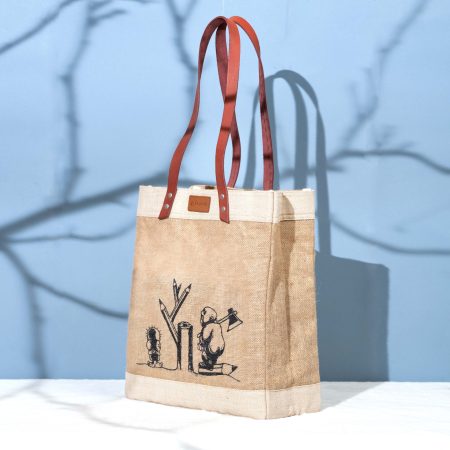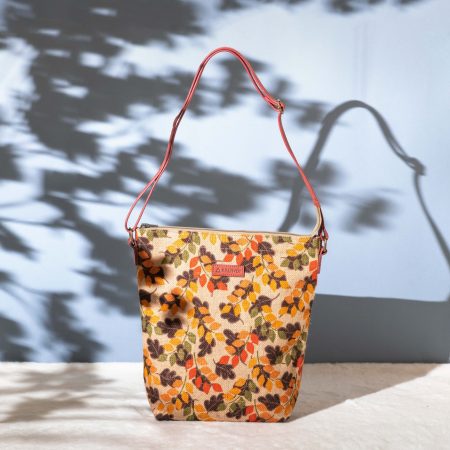Teesta
৳ 1,900.00 ৳ 1,520.00
কালিন্দী’র ব্যাগসম্ভারে নতুন সংযোজন ‘তিস্তা’। আপনার অফিস, ঘুরাঘুরি কিংবা সংক্ষিপ্ত ভ্রমণের সঙ্গী করতে পারেন এই ব্যাগটিকে।
– সাইজ: ১০”×৪.৫”×১২”।
– ম্যাটেরিয়াল: পাট এবং ভেজিটেবল ট্যানড লেদার।
– চারটি ভিন্ন ভিন্ন রঙে পাওয়া যাচ্ছে।
- Delivery & Return
Delivery
আমরা পুরো বাংলাদেশে হোম ডেলিভারি দিয়ে থাকি। ডেলিভারির সময় ২-৫ দিন। পণ্যের আকার, ওজন এবং আপনার লোকেশনের উপর নির্ভর করে ৮০-১৫০ টাকা ডেলিভারি চার্জ প্রযোজ্য।Return
আমরা প্রতিটি পণ্য খুবই যত্নের সাথে কোয়ালিটি কন্ট্রোল করি। পণ্যটি নেওয়ার সময় অবশ্যই ভালোভাবে চেক করে নেওয়ার অনুরোধ রইল। এর পরও যদি কোন সমস্যা হয় তাহলে ডেলিভারির ৭ দিনের মধ্যে রিফান্ডের (শর্ত সাপেক্ষে) ব্যবস্থা আছে।Help
যেকোন প্রয়োজনে আমাদের সাথে যোগাযোগ করুন। Facebook: https://www.facebook.com/kalindi.com.bd Phone: +880 1810151890 Email: [email protected]
তিস্তা
তিস্তা নদী সিকিমের হিমালয় পর্বতমালার ৭২০০ মিটার উচ্চতায় অবস্থিত চিতামু হ্রদ থেকে সৃষ্টি হয়েছে। এটি দার্জিলিংয়ে অবস্থিত শিভক গোলা নামে পরিচিত একটি গিরিসংকটের মধ্য দিয়ে প্রবাহিত হয়েছে। পার্বত্য এলাকা থেকে প্রথমে নদীটি দার্জিলিং সমভূমিতে নেমে আসে এবং পরে পশ্চিমবঙ্গের ডুয়ার্স সমভূমির উপর দিয়ে প্রবাহিত হয়ে বাংলাদেশে প্রবেশ করে ব্রহ্মপুত্র নদের সঙ্গে মিলিত হয়েছে। তিস্তা নদীর সর্বমোট দৈর্ঘ্য ৩১৫ কিমি, তার মধ্যে ১১৫ কিমি বাংলাদেশ ভূখণ্ডে অবস্থিত। আগে নদীটি জলপাইগুড়ির দক্ষিণে তিনটি ধারায় প্রবাহিত হতো (পূর্বে করতোয়া, পশ্চিমে পুনর্ভবা ও মধ্যে আত্রাই)।
তিস্তার জন্ম বৃত্তান্ত সম্পর্কে ‘কালিকা পুরাণ’-এ বলা হয়েছে পার্বতীর বুক থেকে তিনটি ধারা বের হয়ে ত্রিস্রোতা বা তিস্তার জন্ম। প্রাচীনকালে ঋক বৈদিক যুগে নদীটির নাম ছিল ‘সদানীর’। লেপচা ভাষায় তিস্তার নাম রং-ন্যু। যার অর্থ সোজা পথে প্রবাহিত নদী। তিব্বতীরা আদর করে এর নাম দিয়েছে ‘সাং-ছু’ অর্থাৎ বিশুদ্ধজল। একাদশ-দ্বাদশ শতাব্দীতে লেখা কবি ভবানী দাসের ‘ময়নামতি’ পুঁথিতে তিস্তার উল্লেখ আছে। এই নদীর তীরে রানী ময়নামতীর পুত্র গোবিন্দ চন্দ্রের রাজ্যাভিষেক হয়েছিল ধর্মপালের সঙ্গে যুদ্ধ করে।
উত্তরের জীবন রেখা বলা হয় তিস্তা নদীকে। একসময়ের প্রমত্তা তিস্তা নদীতে এখন পানি না থাকায় দেশি প্রজাতির মাছ, জেলে, নৌকা, নদীপাড়ের জীববৈচিত্র্যের ওপর প্রভাব পড়েছে। তবে নদীর বুকে জেগে ওঠা চরে ফসল ফলিয়ে খাদ্যের জোগান দিয়ে নীরব বিপ্লব ঘটিয়ে যাচ্ছেন চরের কৃষকরা। প্রতি বছর এসব চরে ৩৩ প্রকার ফসল চাষাবাদ হচ্ছে। যা প্রায় ৩৫ থেকে ৪০ হাজার কোটি টাকার ফসল উৎপাদন হয়ে থাকে। এ ছাড়া বছরে ২৫ লাখ গবাদিপশুর জোগান দিচ্ছে চরে বসবাসকারীরা। রংপুর কৃষি অঞ্চল দপ্তরের তথ্যমতে, নীলফামারী, রংপুর, লালমনিরহাট ও কুড়িগ্রাম জেলার তিস্তার নদীবেষ্টিত ১৫৪টি চরের জমির পরিমাণ সাড়ে ১৯ হাজার হেক্টর। বন্যার পর চরের মাটিতে পলি জমে। এ কারণে সার খুব একটা লাগে না। পোকামাকড়েরও আক্রমণ কম, কীটনাশকের ব্যয় তেমন নেই। তাই ফসল উৎপাদনে খরচও কম।
Teesta
The Teesta River originates from Chitamu Lake at an elevation of 7,200 meters in the Himalayas of Sikkim. It flows through a gorge known as Shivok Gola in Darjeeling. From the mountainous region, the river descends into the Darjeeling plains and then flows over the Duars plains of West Bengal before entering Bangladesh, where it merges with the Brahmaputra River. The total length of the Teesta River is 315 kilometers, with 115 kilometers of it flowing through Bangladesh. Historically, the river used to flow in three branches south of Jalpaiguri: eastward to the Karatoa, westward to the Punabhaba, and through the middle to the Atrai.
According to the ‘Kalika Purana,’ the Teesta River was born from three streams flowing from Parvati’s bosom, hence the name Trisrota or Teesta. In ancient times, during the Rig Vedic era, the river was known as ‘Sadanira.’ In the Lepcha language, the Teesta is called ‘Rongnyu,’ meaning ‘straight-flowing river.’ Tibetans affectionately named it ‘Sang Chu,’ which means ‘pure water.’ The river is mentioned in the ‘Moinamoti’ manuscript by poet Bhavani Das, written in the eleventh-twelfth century. Queen Moinamoti’s son Govinda Chandra was coronated on the banks of this river after a battle with Dharmapala.
The Teesta River is known as the lifeline of northern Bangladesh. Once a mighty river, the Teesta now suffers from a lack of water, affecting native fish species, fishermen, boats, and the riverbank’s biodiversity. However, farmers cultivating the land on the river’s emerging char areas are silently revolutionizing food production. These chars produce 33 types of crops annually, yielding produce worth approximately 35 to 40 thousand crore BDT. Additionally, char dwellers supply 2.5 million livestock annually. According to the Rangpur Agricultural Zone office, the land area of 154 chars along the Teesta in Nilphamari, Rangpur, Lalmonirhat, and Kurigram districts totals around 19,500 hectares. After flooding, silt deposits on the char lands make fertilizer largely unnecessary, and pest attacks are minimal, reducing the need for pesticides. Consequently, the cost of crop production is low.
The Teesta River’s role in agriculture is vital, with its fertile char lands supporting a substantial portion of the region’s food production. The unique ecological conditions of these char areas provide an ideal environment for diverse crop cultivation with minimal agricultural inputs. The river continues to be a critical resource for the livelihoods of many in the northern districts of Bangladesh.
Related Products
যারা কালিন্দীতে ছোটো এবং হালকা ওজনের ব্যাগ খুঁজছেন তাদের জন্য “খোলপেটুয়া” নামের এই ব্যাগটি। উন্নতমানের মসৃণ চামড়া দিয়ে তৈরি এই ব্যাগটির সাথে আছে কাঁধে ঝুলানোর জন্য টেকসই লেদারের স্ট্রাপ।
– সাইজঃ ৬” × ৯.৫” × ৪.৫” ইঞ্চি।
– মেটেরিয়ালঃ অরিজিনাল লেদার।
Out of stock
To ease your daily commute, Kalindi designed this tote bag named Shibsha. It has plenty of space for carrying essentials. Because of its lightweight, it is comfortable to carry on the shoulder.
– Measurements: 15″×12.5″×5″
– Material: High quality jute fabric and vegetable tanned leather.
আপনার চলার পথকে সহজ করতে কালিন্দী নিয়ে এলো এই টোট ব্যাগটি। প্রয়োজনীয় জিনিসপত্র বহনের জন্য এতে রয়েছে অনেক স্পেস। ওজনে হালকা হওয়ায় কাঁধে ঝুলিয়ে বহন করাটা আরামদায়ক।
– সাইজঃ ১৫”×১২.৫”×৫”।
– মেটেরিয়ালঃ পাট এবং লেদার।
Out of stock
“টোট ব্যাগ” পাটের ব্যাগের ক্ষেত্রে সর্বাধিক পরিচিত এবং খুব জনপ্রিয়।ওজনে হালকা, সাথে অনেক বেশি জায়গা থাকায় মেয়েদের কাছে এই ব্যাগের আলাদা চাহিদা রয়েছে। চিত্রা, শীতলক্ষ্যার পর কালিন্দীতে যুক্ত হলো আরো একটি ফ্যাশনেবল টোট ব্যাগ – “রূপসা”। কালারফুল এই ব্যাগটি যে কোনো পোশাকের সাথে খুব সহজে মানিয়ে যাবে।
– সাইজঃ ১২.৫”×১২”×৪”।
– মেটেরিয়ালঃ পাটের ফেব্রিক এবং লেদার।
কালিন্দীর নতুন ব্যাগ – ‘মায়া’।
অরিজিনাল লেদারে তৈরি সিম্পল ডিজাইনের এই ব্যাগটি স্টাইলের দিক থেকে ভীষণ গর্জিয়াস।
– মেটেরিয়ালঃ অরিজিনাল লেদার।
– সাইজঃ হাইট- ১১ ইঞ্চি, লেন্থ- ১৫ ইঞ্চি, ওইথ- ৩.৫ ইঞ্চি।
Out of stock
সিম্পল, একই সাথে স্টাইলিশ পাটের ব্যাগ “পায়ারা”। পার্টি, অফিস গোয়িং, অথবা রেগুলার ব্যবহার এর জন্য পার্ফেক্ট একটি ব্যাগ। এছাড়া ফ্যাশনেবল এই ব্যাগটি মানিয়ে যাবে যে কোনো বয়সের সাথে।
– সাইজ: ১১” × ১০” × ৫”।
– মেটেরিয়ালঃ ১০০% পাট এবং লেদার।
Out of stock
ভ্রমণ অথবা রেগুলার ব্যবহারের জন্য ব্যাকপ্যাক আরামদায়ক ক্যারি ব্যাগ হিসেবে সুপরিচিত।এর একটি উল্লেখযোগ্য কারন এই ব্যাগগুলোতে ডাবল হ্যান্ডেল থাকে,এবং তা কাঁধে বহন করা যায়।কাঁধে বহন করায় ব্যাগের মূল ভার পিঠের উপর ছড়িয়ে যায়,যার ফলে ব্যাগ ক্যারি করতে কষ্ট কম হয়।
নতুন বছরে কালিন্দীতে যোগ হলো “কংস” নামের এই ব্যাকপ্যাকটি।
– সাইজ: ১৪” × ১১” × ৫”
– ম্যাটেরিয়াল: জুট এবং লেদার।
উন্নতমানের পাটের ফেব্রিক এবং ভেজিটেবল ট্যানড লেদার দিয়ে তৈরি ব্যাগটি আপনাকে দিবে নান্দনিকতার ছোয়া। কাঁধে ঝুলানোর জন্য আছে টেকসই লেদারের স্ট্রাপ, তাই ব্যাগটি বহন করে আরাম। ভিতরে চওড়া খোলা জায়গা এবং মোবাইল ফোন রাখার জন্য আলাদা একটি জিপার পকেট আছে।
– সাইজ: ৯” × ২.৫”
– ম্যাটেরিয়াল: ১০০% পাট এবং লেদার স্ট্র্যাপ।
জলপদ্মের মোটিফে কালিন্দীর সংযোজন জুট ব্যাগ ‘লিলি’। শাড়ি কিংবা কূর্তি, অফিস অথবা চা আড্ডায়, যে কোনো পোশাক এবং যে কোনো জায়গায় অনায়াসে মানিয়ে যাবে এই ব্যাগটি। উন্নত মানের পাটের কাপড় দিয়ে তৈরি এই ব্যাগটি দেখতে ছোট হলেও ভেতরের জায়গায় ধরে যাবে আপনার টুকিটাকি বিশ্ব।
ওজনে হালকা হওয়ায় কাঁধে ঝুলিয়ে বহন করাটা হবে বেশ আরামদায়ক। এই সাইড ব্যাগটি ক্রস বডি হিসাবেও ব্যবহার করা যায়।
– সাইজ: ৮”×১১”×৪”।
– ম্যাটেরিয়াল: ১০০% পাট এবং লেদার স্ট্র্যাপ।
































